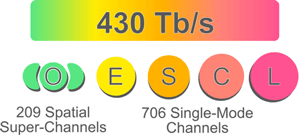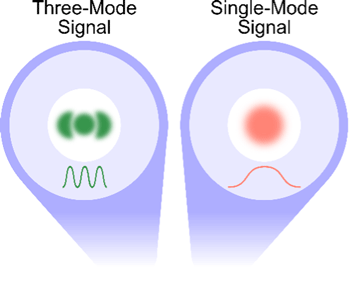Highlights
-
A new optical transmission record of 430 Tb/s, surpassing the previous record of 402 Tb/s.
-
The breakthrough leverages international-standard-compliant, cutoff-shifted optical fibers with a novel approach that triples the capacity of certain spectral regions using spatial-division multiplexing.
-
This innovation promises to enhance metropolitan networks and inter-datacenter links by offering high throughput with reduced complexity, while utilizing existing optical fiber infrastructure.
The National Institute of Information and Communications Technology (NICT, President: TOKUDA Hideyuki, Ph.D.), together with 11 international research partners, has demonstrated a record-breaking 430 terabits per second (Tb/s) optical transmission using a novel approach that extends the capacity of standard-compliant cutoff-shifted optical fibers well beyond the original design.
The technology introduces a novel method that multiplies the usable capacity of certain spectral regions by up to three times. This approach exploits the properties of standard-compliant cutoff-shifted optical fibers based on the ITU-T G.654 recommendation, which have been originally designed to operate with light at relatively long wavelengths, in the C and L bands of transmission bands. By using light with shorter wavelengths, in the O-band region, researchers were able to realize three-mode transmission instead of the traditional single-mode transmission. This effectively extended the optical fiber capacity well beyond the intended design by combining single-mode transmission in the E/S/C/L bands with three-mode transmission in the O band. The team achieved a new optical transmission record of 430 Tb/s in international-standard-compliant optical fibers, surpassing the previous our record of 402 Tb/s, which was also set in 2024. Remarkably, the new result was obtained using nearly 20% less overall bandwidth, resulting in a simpler system that demonstrates how existing infrastructure can be pushed even further without costly upgrades.
The new technology builds on standard-compliant cutoff-shifted optical fiber technology and has the potential to be applied to metropolitan area networks and inter-datacenter links, where high-capacity connections are increasingly in demand, and standard-compliant cutoff-shifted optical fibers are already installed. The combination of high throughput, reduced complexity, and compatibility with existing infrastructure points to a more scalable and energy-efficient future for optical communications.
This achievement was reported as a post deadline paper at the 51st European Conference on Optical Communication (ECOC) 2025 on Thursday Oct. 2, 2025, at the Bella Center, Copenhagen, Denmark, and was partly supported by the Japan-Germany Beyond 5G/6G collaboration initiative.
Background

Figure 1. Wavelength bands used in this work with single-mode E/S/C/L-bands and three-mode O-band.
New, data-driven internet services, including AI, have driven a surge in demand for optical fiber transmission bandwidth. Multi-band wavelength-division multiplexing (WDM) technology can significantly increase fiber capacity. This has been demonstrated in previous work using the O/E/S/C/L/U transmission bands, which utilize most of the available bandwidth in the low-loss region of optical fibers. However, without the availability of new spectral regions, the capacity of these systems is ultimately limited, necessitating the development of new fiber technologies to achieve even higher capacities.
In this demonstration, we surpassed previous limits by leveraging the fundamental physics of light transmission in specific types of standard-compliant optical fibers. We showed that the cutoff-shifted fibers defined in ITU-T G.654 recommendation can support multi-mode transmission when using O-band lightwaves, which have shorter wavelengths compared to the C and L bands that typically support only single-mode transmission. In these fibers, we were able to triple the capacity of the O-band. Combined with transmission in the E, S, C, and L bands—similar to our previous work—we achieved a record capacity of 430.2 Tb/s.
Achievements
Together with its partners, NICT developed the world’s first joint few- and single-mode transmission system capable of WDM transmission using commercially available standard G.654-compliant optical fiber. The demonstration combined few-mode transmission in the O-band with single-mode transmission across the E/S/C/L-bands.
A wideband WDM signal was generated, comprising up to 209 spatial super-channels in the O-band and 706 channels across the E/S/C/L-bands, spanning a total bandwidth of 30.1 THz (1,280.4 nm to 1,608.9 nm) as shown in Figure 1. This signal was transmitted over 10 km of ITU-T G.654-B/D-compatible fiber. High data rates were achieved using dual-polarization quadrature amplitude modulation (DP-QAM) with up to 256 symbols per constellation. The generalized mutual information (GMI)-based estimated data rate after 10 km transmission reached 430.2 Tb/s. This surpasses the previously reported highest data rate in single-mode fiber (SMF), despite the aggregate transmission bandwidth (30.1 THz) being nearly 20% lower. Table 1 compares this result with our past achievements in wideband transmission experiments based on single-mode optical fiber transmission. These findings demonstrate that spatial division multiplexing can unlock untapped transmission resources in standard-compliant optical fibers.
Table 1. Comparison of wideband transmission demonstrations.

New optical fiber technologies for ultra-high capacity are essential to support communication systems beyond 5G. To reduce adoption costs and implementation time, these technologies should be compatible with existing fiber infrastructure. Leveraging current networks enables faster deployment, improved efficiency, and reliable high-speed data transmission for future digital communication systems. The paper containing these results was presented at the post deadline session of the 51st European Conference on Optical Communication (ECOC) 2025, having been selected as a post deadline paper.
Future Prospects
NICT will continue to promote research and development into new technologies, components, and fibers to support new transmission windows for both near and long-term applications. NICT will also aim to extend the transmission range of such wideband, ultra-high-capacity systems and their compatibility for field deployed fibers.
Reference
European Conference on Optical Communication (ECOC) 2025, Post Deadline Session
Title: 430 Tb/s GMI data rate over a standard G.654 fiber using few-mode O-band and single-mode ESCL-band transmission
Authors: Ruben. S. Luis, Daniele Orsuti, Robert Emmerich, Aleksandr Donodin, Menno van den Hout, Stefano Gaiani, Besma Kalla, Lucas Zischler, Robson A. Colares, Julian Schneck, Shin Sato, Yuki Kawaguchi, Takemi Hasegawa, Tetsuya Hayashi, Simon Gross, Mark Bakovic, Michael Withford, Nicolas K. Fontaine, Mikael Mazur, Lauren Dallachiesa, Haoshuo Chen, Georg Rademacher, Roland Ryf, David Neilson, David A. Mello, Cristian Antonelli, Sergey Turitsyn, Tom Bradley, Pierpaolo Boffi, Chigo Okonkwo, Ronald Freund, Colja Schubert, and Hideaki Furukawa
Previous NICT Press Releases
- World Record 402 Tb/s Transmission in a Standard Commercially Available Optical Fiber
https://www.nict.go.jp/en/press/2024/06/26-1.html - World Record 301 Tb/s Transmission in a Standard Commercially Available Optical Fiber
https://www.nict.go.jp/en/press/2024/01/29-1.html - World's First Successful Transmission of 1 Petabit per Second in a Standard Cladding Diameter Multi-core Fiber
https://www.nict.go.jp/en/press/2022/05/30-1.html





 ml.nict.go.jp
ml.nict.go.jp